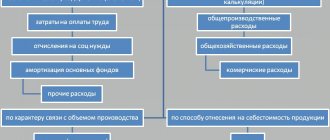Accounting for semi-finished products of own production and their evaluation
Semi-finished products of our own production are materials that have been processed at a completed technological stage. They can be used for subsequent processing at the same enterprise or can be sold to a counterparty for further processing.
At full-cycle enterprises, where raw materials go through several stages of processing or reprocessing, account 21 “Semi-finished products of own production” can be used to account for semi-finished products produced in each processing stage.
Semi-finished products of own production can be classified as work in progress (clause 63 of the Regulations on accounting and financial reporting No. 34n, approved by the Ministry of Finance on July 29, 1998). There are several methods of assessment:
According to the requirements of Article 319 of the Tax Code of the Russian Federation, the cost of semi-finished products of own production is determined based on the assessment of finished products. Therefore, in tax accounting only one assessment method is used:
- Direct costs of the enterprise.
The accounting policy must include a list of direct expenses (letter of the Ministry of Finance No. 03-03-06/4/78 dated August 26, 2010). For example, the list of direct expenses includes: material costs, labor costs, social contributions, accrued depreciation.
When calculating the cost of finished products, semi-finished products of own production are included in the calculation in the form of a complex item or are included in detailed cost items.
EXAMPLE No. 1
Lyutik LLC established in its accounting policy for tax purposes the procedure for allocating production and sales expenses incurred during the reporting period by analogy with the procedure used for accounting purposes: “...materials and purchased components used for orders of the main production should be taken into account as part of indirect costs."
When conducting an on-site tax audit, tax inspectors proved the direct connection of material costs with the production process, as well as their order-by-order accounting by the organization: thus, materials transferred to production on the basis of invoice requirements, limit cards and orders according to statement 19.5 are taken into account in accounting and relate to specific products, and for tax accounting purposes are unreasonably written off directly upon transfer to production.
Thus, materials and purchased components directly included in the manufactured products are subject to accounting as part of direct costs (Resolution of the Presidium of the Supreme Arbitration Court of the Russian Federation dated November 2, 2010 No. 8617/10, FAS of the Ural District dated May 6, 2010 No. F09-3091 /10-С3 and dated 02/25/2010 No. Ф09-799/10-С3).
2) Expenses for remuneration of personnel involved in the process of production of goods, performance of work, provision of services.
Account 21 in accounting
Semi-finished products of own production are accounted for on account 21 in correspondence with account 20 - when semi-finished products are used in own production, and with account 90 - when semi-finished products are sold to a counterparty:
The debit of account 21 reflects the receipt of semi-finished products and their surpluses discovered during inventory. The account credit takes into account the consumption of semi-finished products during transfer for subsequent processing, their sale or identification of shortages in the warehouse.
On account 21, analytical accounting can be maintained by storage location, by name, type, grade, and so on.
Valuation based on the cost of raw materials and materials
This method of assessing semi-finished products of own production is the simplest, but it does not give a complete picture of all the costs of their production. Errors can be considered small if the main costs for the production of semi-finished products fall on the cost of the products, and the costs of their processing have an insignificant share (example 1).
Example 1. At the manufacturing enterprise Mir LLC, workshop No. 1 produces semi-finished products of its own production “A” and “B”.
In the reporting period, for the production of 800 pcs. semi-finished products “A”, raw materials worth 80,000 rubles were used, and for the manufacture of 500 pcs. semi-finished products “B” - in the amount of 40,000 rubles.
After that 500 pcs. semi-finished products “A” and 300 pcs. semi-finished products “B” were used to manufacture our own products, and the remaining part was sold to third parties.
Let us assume that the accounting policy of Mir LLC provides for the assessment of semi-finished products of its own production at the cost of raw materials. Then the accounting cost of semi-finished product “A” will be 100 rubles. per piece (80,000 rubles: 800 pcs.), and semi-finished product “B” - 80 rubles. per piece (RUB 40,000: 500 pcs.).
The cost of semi-finished products intended for the manufacture of own products will be:
for semi-finished products of own production “A” - 50,000 rubles. (100 rub. x 500 pcs.);
in terms of semi-finished products of own production “B” - 24,000 rubles. (80 RUR x 300 pcs.).
The cost of semi-finished products sold to third parties will be:
for semi-finished products of own production “A” - 30,000 rubles. (100 rub. x 300 pcs.);
in terms of semi-finished products of own production “B” - 16,000 rubles. (80 RUR x 200 pcs.).
Since semi-finished products of our own production are intended both for our own needs and for sale to third parties, it is advisable for Mir LLC to keep separate records of semi-finished products. Therefore, to account 21 “Semi-finished products of own production”, it is necessary to open subaccounts 1 “Semi-finished products of own production “A” and 2 “Semi-finished products of own production “B”.
The following entries will be made in the accounting records of Mir LLC:
Debit 21, subaccount 1 “Semi-finished products of own production “A”, Credit 20
80,000 rub. — the cost of raw materials used for the production of semi-finished products “A” is included in the cost price;
Debit 21, subaccount 2 “Semi-finished products of own production “B”, Credit 20
40,000 rub. — the cost of raw materials used for the production of semi-finished products “B” is included in the cost price;
Debit 20 Credit 21, subaccount 1 “Semi-finished products of own production “A”,
50,000 rub. — the cost of semi-finished products of own production “A”, intended for the manufacture of own products, was written off;
Debit 20 Credit 21, subaccount 2 “Semi-finished products of own production “B”,
24,000 rub. — the cost of semi-finished products of own production “B”, intended for the manufacture of own products, was written off;
Debit 90, subaccount 2 “Cost of sales”, Credit 21, subaccount 1 “Semi-finished products of own production “A”,
30,000 rub. — the cost of semi-finished products of own production “A” sold to third parties was written off;
Debit 90, subaccount 2 “Cost of sales”, Credit 21, subaccount 2 “Semi-finished products of own production “B”,
16,000 rub. — the cost of semi-finished products of own production “B” sold to third parties was written off.
Typical postings for 21 accounts “Semi-finished products of own production”
The main entries for 21 accounts used in accounting are shown in the table below:
| Account debit | Account credit | Operation description |
| 21 | 20 | Receipt of semi-finished products of own production |
| 21 | 23 | Receipt of semi-finished products manufactured by auxiliary production |
| 21 | 40 | Receipt of finished products for subsequent use as semi-finished products |
| 21 | 91.01 | Surplus semi-finished products identified during inventory were capitalized |
| 20 | 21 | Semi-finished products are sent to production for subsequent processing |
| 23 (25;26) | 21 | The cost of semi-finished products is included in the costs of auxiliary production (overall production costs; general business expenses) |
| 28 | 21 | Write-off of defective semi-finished products of own production |
| 91.02 | 21 | The cost of semi-finished products of own production, written off or sold, is reflected in other expenses |
| 94 | 21 | The identified shortage of semi-finished products is reflected |
Valuation based on actual production costs
This method of evaluating semi-finished products of own production is used by organizations for single and small-scale production.
Valuation of semi-finished products at actual production costs includes all costs associated with their production, both direct and indirect.
Wages of production workers and deductions from it, routine maintenance and repair of equipment are distributed in proportion to the amount of material costs taken into account in the cost of semi-finished products.
The same procedure for allocating costs is prescribed in the accounting policy for indirect costs (example 3).
Example 3. Let's change the conditions of the previous example, taking into account the fact that not all costs can be distributed among semi-finished products.
The accounting policy of Mir LLC provides for the assessment of semi-finished products of its own production at the actual production cost.
Let's calculate the cost distribution coefficient based on the cost of raw materials used in the production of semi-finished products, which will be:
to take into account actual costs in the cost of semi-finished products “A” - 66.7% (80,000 rubles: 120,000 rubles);
to take into account actual costs in the cost of semi-finished products “B” - 33.3% (40,000 rubles: 120,000 rubles).
The distribution of costs based on the cost of raw materials used in the production of semi-finished products will look as follows (table).
| Cost item | The amount of expenses related to the production of semi-finished products “A” | The amount of expenses related to the production of semi-finished products “B” |
| Costs of materials and raw materials | 80,000 rub. | 40,000 rub. |
| Wages of production workers | RUB 80,040 (RUB 120,000 x 66.7%) | RUB 39,960 (RUB 120,000 x 33.3%) |
| Insurance premiums | RUR 73,370 (RUB 110,000 x 66.7%) | RUB 36,630 (RUB 110,000 x 33.3%) |
| Depreciation of fixed assets | 2,000 rub. | 1,500 rub. |
| Routine maintenance and repair of equipment | 400.2 rub. (RUB 600 x 66.7%) | 199.8 rub. (RUB 600 x 33.3%) |
Thus, the actual cost of semi-finished products of own production “A” will be 235,810.2 rubles. (80,000 rub. + 80,040 rub. + 73,370 rub. + 2,000 rub. + 400.2 rub.), and the cost of semi-finished products of own production “B” is 118,289.8 rub. (RUB 40,000 + RUB 39,960 + RUB 36,630 + RUB 1,500 + RUB 199.8).
Let us assume that the manufacturing enterprise Mir LLC uses the non-semi-finished method of accounting for semi-finished products and the cost of semi-finished products is immediately reflected in account 20 “Main production” as part of the costs of production. Then the following entries will be made in the accounting records of Mir LLC:
Debit 20 Credit 10, 70, 69, 02, 60
RUB 235,810.2 — actual costs associated with the production of semi-finished products of our own production “A” are reflected;
Debit 20 Credit 10, 70, 69, 02, 60
RUB 118,289.8 — actual costs associated with the production of semi-finished products of our own production “B” are reflected.
Examples of transactions on 21 accounts
Example 1. The cost of semi-finished products includes only the cost of raw materials and materials
Let's say VESNA LLC produces parts that are used in its own production. In January 2021, 150 parts were manufactured. The costs included:
- Raw materials and materials - 1,200,000 rubles;
- Salary and social contributions - 980,000 rubles;
- Depreciation charges - 450,000 rubles.
Semi-finished products are valued at the cost of raw materials and materials. Generated postings:
| Dt | CT | Amount, rub. | Wiring Description | A document base |
| 20 | 10 | 1 200 000 | The cost of raw materials and materials written off for the manufacture of parts is taken into account | Requirement invoice |
| 20 | 70 (69); 02 | 1 430 000 | Costs (wages, social contributions, depreciation) for the production of finished products are reflected | Payroll. Depreciation calculation |
| 21 | 20 | 1 200 000 | Semi-finished products are received into the warehouse | Shift production report |
| 20 | 21 | 1 200 000 | Semi-finished products transferred to production | Requirement invoice |
Example 2: Semi-finished products are valued at direct costs
Let's look at the previous example: VESNA LLC produces parts that are used in its own production. In January 2021, 150 parts were manufactured. Costs include:
- Raw materials and materials - 1,200,000 rubles;
- Salary and social contributions - 980,000 rubles;
- Depreciation charges - 450,000 rubles.
Semi-finished products of own production are valued at direct costs: raw materials and materials; salary; social contributions; accrued depreciation and so on, according to accounting policies. Generated postings:
| Dt | CT | Amount, rub. | Wiring Description | A document base |
| 20 | 10 | 1 200 000 | The cost of raw materials and materials written off for the manufacture of parts is taken into account | Requirement invoice |
| 20 | 70 (69) | 980 000 | The amount of salary and social contributions is reflected | Payroll. |
| 20 | 02 | 450 000 | Accrued depreciation reflected | Depreciation calculation. |
| 21 | 20 | 2 630 000 | Receipt of semi-finished products of own production to the warehouse (1,200,000 + 980,000 + 450,000) | Shift production report |
EXAMPLE No. 4
Lyutik LLC assembles, produces and sells cars. The accounting policy for tax purposes establishes that depreciation charges for all fixed assets are included in indirect expenses.
During an on-site tax audit, tax inspectors proved that the costs associated with the depreciation of fixed assets directly used in the production of cars were unlawfully excluded by the taxpayer from direct expenses.
Thus, depreciation of fixed assets directly involved in the production of products is inextricably linked with the production process and must be included in direct costs (Resolution of the Federal Antimonopoly Service of the North-Western District dated October 15, 2013 No. A56-63786/2012).
These examples show only cases that taxpayers have lost, based on the principle “forewarned is forearmed.” Giving the taxpayer the opportunity to independently determine accounting policies (Letters of the Ministry of Finance of the Russian Federation dated December 7, 2012 No. 03-03-06/1/637, dated November 29, 2011 No. 03-03-06/1/785, dated May 25, 2010 No. 03-03-06/2/101, dated November 12, 2009 No. 03-03-06/1/742, etc.), including the formation of the composition of direct expenses, the Tax Code of the Russian Federation does not consider this process as depending solely on the will taxpayer. As noted in the Determination of the Supreme Arbitration Court of the Russian Federation dated May 13, 2010 No. VAS-5306/10, these standards classify direct expenses as costs directly related to the production of goods (performance of work, provision of services). The organization can, at its discretion, either narrow or expand the list of direct expenses. However, it must be remembered that in accordance with the requirements of Art. 252 of the Tax Code of the Russian Federation, the taxpayer’s decision must be economically justified.
Algorithm for calculating direct costs attributable to the remains of semi-finished products of own production
Accounting for semi-finished products of own production is carried out in the context of accounting objects (nomenclature items and/or groups of nomenclature items of produced semi-finished products) and their territorial location.
Calculation of balances of semi-finished products of own production according to direct costs at the end of the reporting period can be divided into 2 stages:
Stage 1 - calculation (removal) of the balances of semi-finished products of own production in physical terms.
Stage 2 - calculation of the balances of semi-finished products of own production in value terms (based on direct costs).
Stage 1 - Inventory of semi-finished products
When making an inventory of semi-finished products of own production (for example, at enterprises of the machine-building complex), it is necessary to determine the actual presence of backlogs (parts, assemblies, assemblies, semi-finished products) and unfinished production and assembly of products in production.
Inspection of work in progress (parts, assemblies, assemblies, semi-finished products) is carried out by actual counting and weighing.
Inventory lists are compiled separately for each separate structural unit (workshop, site, department), indicating the name of the reserves, the stage or degree of their readiness, quantity or volume.
For semi-finished products of own production, which are a heterogeneous mass or mixture of raw materials, two quantitative indicators are given in inventories, as well as in comparison sheets: the amount of this mass or mixture and the amount of raw materials or materials (by individual items) included in its composition. The quantity of raw materials or materials is determined by technical calculations in the manner established by industry instructions on planning, accounting and calculating the cost of products (works, services).
In the Resolution of the Federal Antimonopoly Service of the West Siberian District dated January 24, 2013 No. A81-4906/2011 (Determination of the Supreme Arbitration Court of the Russian Federation dated March 18, 2013 No. VAS-3405/13, the transfer of the case to the Presidium of the Supreme Arbitration Court was refused) it is noted that as primary documentation Inventory documents can be used to evaluate work in progress. In this case, in its accounting policy, the organization should indicate the composition of the documents used to document the inventory results.
Stage 2 - Calculation of the cost of semi-finished products
After the balances of semi-finished products of own production have been determined in physical terms (based on operational accounting data and (or) inventory data), it is necessary to calculate their value in tax accounting.
As already noted, the remains of semi-finished products of own production are classified as work in progress. According to Art. 319 of the Tax Code of the Russian Federation, the assessment of the balances of work in progress (including the remains of semi-finished products) at the end of the current month is made on the basis of data from primary accounting documents on the movement and balances (in quantitative terms) of raw materials and materials, finished products by workshops (productions and other production divisions of the taxpayer) and tax accounting data on the amount of direct expenses incurred in the current month.
The taxpayer independently determines the procedure for allocating direct expenses to the balances of work in progress and to products manufactured in the current month (work performed, services rendered), taking into account the correspondence of the expenses incurred to the manufactured products (work performed, services rendered).
Let us use a specific example to show a possible option for tax accounting for semi-finished products of own production at a machine-building enterprise.









